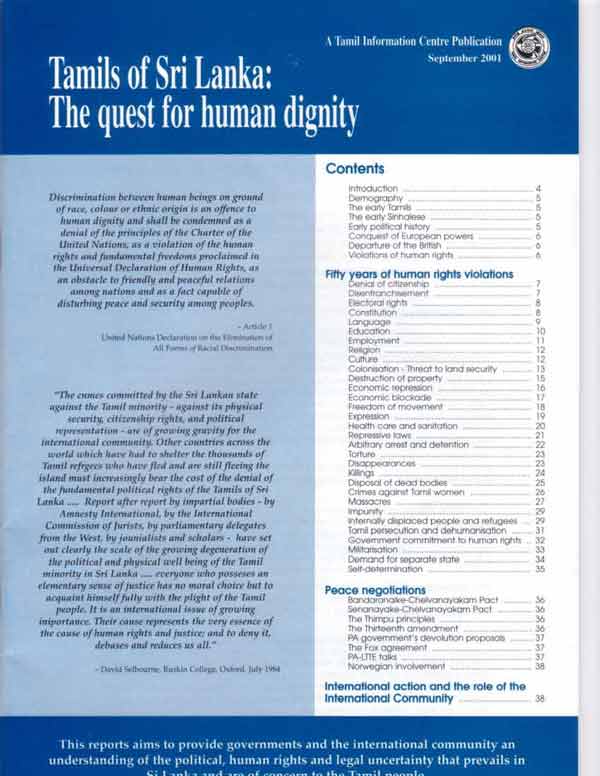Tamils of Sri Lanka: The quest for human dignity |
|||

IntroductionThe Sri Lankan conflict
has reached a crucial stage. The government believes that only a
military victory can enable it to bring about a political solution and
the Liberation Tigers of Tamil Eelam (LTTE) have announced their
position for a peaceful settlement: “Our
liberation organisation is prepared to participate in negotiations to
find a political solution to the ethnic conflict through peaceful means.
We are not opposed to peaceful process of resolving conflicts. Nor are
we reluctant to engage in peaceful dialogue. We are seeking a negotiated
settlement that would be fair, just, and equitable and that would
satisfy the political aspirations of the Tamil people. I explained this
position very clearly when I met the Norwegian peace delegates in Vanni
recently. We are not imposing any pre-conditions for peace talks. Yet we
insist on the creation of a cordial atmosphere and conditions of
normalcy conducive for peace negotiations. It is practically difficult
for both the parties who have been involved in a savage and bloody war
for the last two decades with the mutual animosity and distrust to
suddenly enter into a peace process, while continuing hostilities. It is
precisely for this reason we propose a process of de-escalation of war
leading to cessation of armed hostilities and the creation of a
peaceful, cordial environment.” - Velupillai Prabhakaran, There is
a misconception that the LTTE’s position does not represent the views
of the wider Tamil community. A close analysis of the LTTE stand would
reveal that their position reflects the genuine grievances of the Tamil
people, which unfortunately have never been understood and addressed by
successive Sinhalese governments. Sri
Lankan Tamils believe that Sri Lanka belongs to them as much as any
other community and they are entitled to rights and aspirations as any
other group of people. Tamils are severely marginalised and feel that
they are losing their place irretrievably. This is a process that the
Tamil parliamentarians are still unable to arrest. In fact, the Sri
Lankan parliamentary system has legitimised the marginalisation.
Consequently, Sri Lankan Tamils are unable to develop themselves as full
citizens. In addition to constitutional manipulation and blatantly
discriminatory legislation and administrative action, violence has been
perpetrated systematically against the Tamil community, threatening
their very existence as a people. Tamils
see youth militancy as the inevitable result of political mismanagement.
The youth correctly argue for cessation if the legitimate rights of the
Tamils are not recognised within a united Sri Lanka and their human
rights are not protected by the rule of law. Today,
the LTTE has emerged as the main voice for Tamil grievances. If there
are indications of inflexibility, it is because of a lack of trust in
Sri Lankan governments that have reneged on negotiated agreements. The
international community should see the problem in this light as
otherwise it could be interpreted that all seemingly good proposals are
being rejected. The implementation of political arrangements made out in
the District Development Council system and the Thirteenth Amendment to
the Constitution show clearly that Tamil fears are genuine. The Tamil
struggle must not be seen in terms of “terrorism” and “military
campaigns”, but as fears of a community, which has been at the
receiving end of political discrimination and persecution for the last
fifty years and has never been able to realise its just demands. |
This
Tamil Information Centre Publication is now available via. the Ilankai
Tamil Sangam, USA. It is a well-researched document that comprehensively outlines the experiences of the Tamil people in Sri Lanka (Ceylon) in the post-independence period; i.e. the last fifty- two years. Starting with a short description of the island and the early history of its two peoples (Sinhalese and Tamils) with their sequential conquest by the Europeans, it then goes on to show how, with the departure of last colonial power, a form of ‘democratic’ government evolved where one nationality steadily and opportunely usurped all the powers over all the people in the island. The ensuing pages describe the use of this ‘state power’ of one (the Sinhala) nation to methodically devastate the other (the Tamil nation) in the country now called Sri Lanka. The description is a classic, albeit an extreme, example of the more current version of genocide. Although
the publication is only forty-two pages long,
it is not only thorough and complete,
but also includes well-chosen quotes from well-known and well-respected independent
sources to authenticate this aggression. This
synopsis is highly recommended as a resource book for all who are
interested in the conflict in Sri Lanka. Cost:
US$ 10.00 (including S&H) in USA and Canada. Make check/MO payable
to Ilankai Tamil sangam and mail to PO Box 46, Maryknoll, NY 10545, USA.
Enquiries: sri@sangam.org Other
countries please contact Tamil Information Centre, 720 Romford Road,
London E12 6BT, UK. Tel: +0208 514 6390 E-mail: ticorg@cs.com |
||